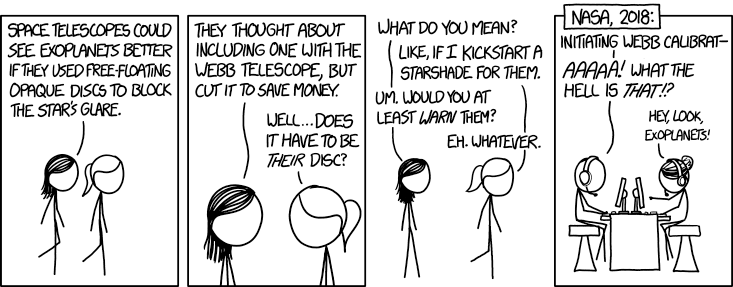Starshade

The New Worlds Mission is already trying to get funding for this, but NASA sponsored their proposal, so it will be hard to catch the telescope people by surprise with it.

The New Worlds Mission is already trying to get funding for this, but NASA sponsored their proposal, so it will be hard to catch the telescope people by surprise with it.
Megan (drawn to look similar to Danish) and Ponytail are talking about space telescopes in general. Megan says that these telescopes could see exoplanets better by using occulting disks, in the form of free floating opaque discs, that could block out light from the exoplanets' stars, thus enabling the telescopes to see the weak light from the planets when the glare of the stars has been diminished.
She continues by explaining that the scientists behind the new James Webb Space Telescope, at the time of the comic scheduled to launch in 2018, thought about including such a disk (a starshade), but that it was cut for budget reasons. Ponytail asks if it has to be their own disk, and then decides to kickstart a fundraiser to build a starshade. Ponytail is referring to the crowdfunding site Kickstarter, although there is no actual project for a starshade for Webb (or for the New Worlds Mission; see title text explanation) on Kickstarter. Megan asks her to at least warn the scientists if she makes the starshade, but Ponytail just replies "whatever".
The final panel shows the NASA control center in 2018 when the Webb telescope is being calibrated. It turns out that Ponytail succeeded and did indeed not warn the scientists. Cueball is surprised by the disc -- presumably because an unfamiliar object suddenly eclipses the star and possibly even seems to "eat" the star -- but Hairbun immediately notices exoplanets, implying that Ponytail's plan worked.
Note that the telescope has partners from 20 countries and is being operated not only by NASA but also by European Space Agency (ESA), Canadian Space Agency (CSA), and the Space Telescope Science Institute (STScI).
The best known space telescope is the Hubble Space Telescope, which was launched back in 1990. The Webb telescope is seen as a successor instrument to Hubble and, because its instruments are designed to work primarily in the infrared region of the electromagnetic spectrum, also as a successor to the Spitzer Space Telescope launched in 2003. In addition to having more sensitive sensors and being larger, Webb will also be located near the L2 Earth–Sun Lagrangian point, and thus not in orbit around Earth. This means that it can keep focusing on a specific point for longer times, while Hubble can see a given point for only about half an hour before moving behind Earth again. When operating in the infrared range as the Webb telescope does (from middle infrared to red and orange visible light), it is important to be outside the atmosphere or at least on very high mountains. Another important feature is to keep the temperature constant and very cool. Since the Webb telescope is always in the light of the sun, this is achieved using protection from a large sunshield.
The title text mentions the New Worlds Mission. This mission is to find exoplanets (hence the name New Worlds) by applying a starshade to block the light of distant stars, so that the planets around the stars are more visible. All discovered exoplanets so far have been found indirectly and not by direct visual observation. The starshade proposed by the New Worlds Mission is a spacecraft designed to work in tandem with a space telescope (not necessarily just the Webb telescope). It is a large occulter that blocks a star's light. One problem with this concept is that light coming from the target star would diffract around the disc and constructively interfere along the central axis. Thus the starlight would still be easily visible, making planet detection impossible. In order to avoid this problem, the proposed starshade is a sunflower-shaped coronagraph disc. The "petals" of the "sunflower" shape are designed to eliminate this diffraction, making exoplanet observation possible. The starshade would fly 72,000 km (45,000 mi) in front of a space telescope (between the telescope and a target star) in order to work. A video demonstrating the starshade is available on the Wikipedia page for the New Worlds Mission. The title text explains that NASA actually sponsored this mission's proposal to build a starshade for the Webb telescope, and concludes that the surprise shown in the comic is not likely to occur in real life. NASA stopped this sponsorship in 2008, and the New Worlds Mission has been looking for additional financing since 2010. Telescope people refers to the engineers and scientists who build, operate, and use space telescopes.
It seems clear that Randall would like to point attention to the New Worlds Mission, possibly hoping for increased funding for the project so a starshade could become a reality for the Webb telescope. That Randall is interested in exoplanets has been demonstrated many times in xkcd.
Note that two of the Webb telescope's instruments, the NIRCam and the MIRI, feature starlight-blocking coronagraphs for observation of faint targets such as exoplanets, so the telescope has ways to improve the visibility of these planets. However, Randall (and the New Worlds Mission) believe that a starshade would be better suited for this task.
The idea of an occulting telescope was used in 975: Occulting Telescope, where it turns out the purpose is to just block all star light, not to see exoplanets.